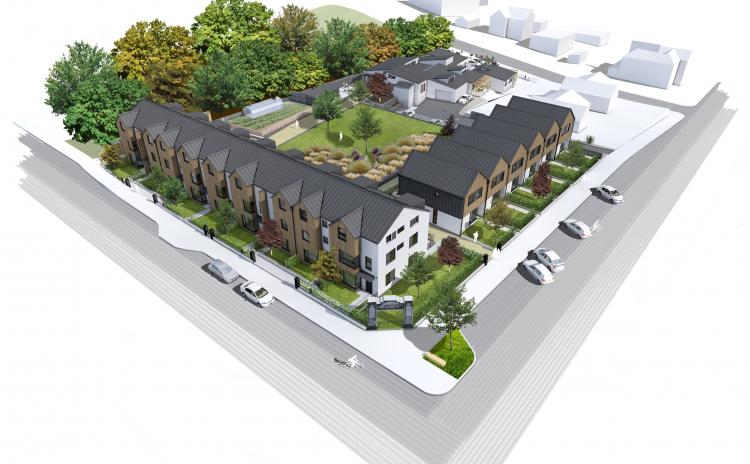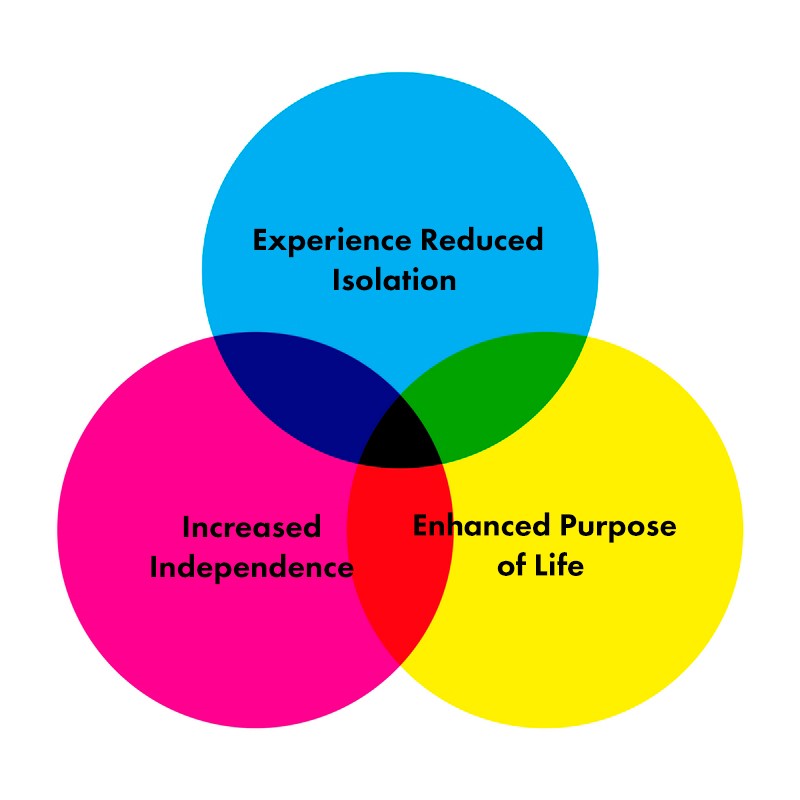Independence through communal living: is cohousing the future?
Senior communal living, many of us don’t know what it is, but this way of living has many benefits!
Written by stannah

Cohousing, or communal living, is a trend that has picked up a lot of steam over the last 40 years and could very well be in your future. However, many people still don’t know much about the subject and associate the idea of communal living with hippy communes of the sixties. While holding hands and singing “Kumbaya” around the campfire is perfectly fine, this isn’t the sort of communal living that we’re talking about.
These are intergenerational communities; some are senior-only, but most of them have people of all ages living in the same cohousing community.
Think about what it used to be like to live in a neighbourhood: everyone knew each other and looked out for each other. You could easily help out by running an errand for someone who needed it. This also extended to childcare, housesitting or simply providing a hot meal for a neighbor because they didn’t have time to cook that day. For seniors, communal living can be a great way to stay independent with a little help from your friends!
Table of contents
What is communal living or cohousing?
What are the benefits for seniors?
Case studies: some examples from around the world
How to start your own (senior) living community
What is communal living or cohousing?

High Street, Otepoti, Dunedin | Source: cohousing.co.nz
The definition of cohousing, or communal living, may vary depending on the source one uses; but it all comes down to the following: a group of people living together, but in their own private homes. It’s an intentional community consisting of a group of private houses that are gathered together around a shared space.
That means you have your own private kitchen and bathroom – you have your own home, but share certain aspects of living. In other words, people live close to, but not with, each other. According to Cohousing New Zealand, the following is essential to cohousing:
- Co-developed, co-designed, and co-organized by residents.
- Extensive common facilities supporting daily life – particularly a common house
- Shared space to enable community interaction, and car-free.
- Resident managed.
- A decision making process free of hierarchy
The following area’s are commonly shared:
- A common house with:
- A large kitchen
- A dining area
- A laundry room
- Recreational spaces
- Parking spaces
- Walkways
- Open space
- Gardens
- Some facilities, like a swimming pool or a sauna
- Shared resources like tools and lawnmowers
The origins of modern communal living and what it is today
When we talk about modern communal living, it goes without saying that people have always lived in shared communes at every age. However, we are going to look at the modern approach, the ideal that came into existance during the 60s and 70s.
The Danish were the first to live together in modern intentional communes or cohousing structures, starting around the end of the 1960s. The idea spread to Sweden and had arrived in the Netherlands by the 1970s. The 1960s was also the decade in which hippies started to set up communes and live together in peace and harmony. Hippies were groups of people who came together because of shared ideals or beliefs, which is not, however, necessarily the case when living in a modern communal setting or cohousing project, which makes a rather big difference.
The idea of cohousing, like what we started to see in Northern Europe during the 60s and 70s, arrived in the US in the early 1990s, and became more common in the UK by the end of the same decade.
What does modern (senior) cohousing look like today?
According to research done by the AARP, the following points define modern cohousing:
- Resident involvement in the planning process
- Common house and other facilities
- Land owned jointly
- Physical layout that encourages interaction
- Collaborative community management
- Between 15 and 35 households (in the US)
- Housing units of an average of 1,250 square feet
- Owned or rented accommodation
Cohousing is for everyone that wants to feel as if they are part of a community – communities like those that used to exist in our neighborhoods. People still want their own space and appreciate their privacy, but like the idea that other people are looking out for them and one another. It’s important to be able to share meals together, work in the garden together or go for walks together. Having someone to take you to the airport or helping out with each other’s (grand)children is, for many, a real blessing in life.
“The beauty of cohousing is that you have a private life and a community life, but only as much of each as you want.” Cohousing resident in Denmark
Who is cohousing meant for?
There isn’t a list of characteristics one must have to be eligible to live communally. In theory, anyone can do it. When we look at current examples, what kinds of people do we usually find living in a communal way?
- Senior Citizens
- Families / Couples
- Singles
- Eco-friendly people
“Whether living in an intergenerational or age-restricted cohousing community, older adults can benefit both socially and economically from the many opportunities to gather together, trade favors, and look after one another that this arrangement encourages.” AARP Factsheet
We will look at the many benefits of communal living for seniors later on in the article. However, one of the biggest reasons for senior citizens to embrace cohousing is that it’s a great way to avoid going to a conventional senior housing facility, like a nursing home. And of course, avoiding isolation and thus loneliness is a very important factor. Families, for example, look for more support when it comes to raising their children, as nowadays, both parents usually have full time jobs. Single people, even though they often enjoy their independence, look for communal living to have a sense of support and/or community that they wouldn’t have when living alone. Eco-friendly people think about ways to reduce their footprint on the planet. When you live in a collaborative setting it’s only logical that the impact one has on the environment is significantly reduced, as a lot can be shared.
Let’s watch and listen to the words of Dr. Erica Elliott who lives in a cohousing community. She lives in an intergenerational cohousing project:
As is the case with Dr. Erica Elliot, the biggest demographic living communally or in cohousing are baby boomers. As this generation has reached, or is almost reaching, the age of 65, they are thinking about their future living arrangements. Members of this generation are known for being independent people, who would not like the idea of spending their golden years in a traditional retirement/nursing home. They are therefore looking for more enriching ways of living, where they can maintain their independence and combine it with social activity and security.
“Cohousing is not such a radical idea; it’s a better way to live, but it does require a little extra effort to make it happen.” Cohousing resident in the US
What are the benefits for seniors?
One of the most important benefits for seniors when living communally is the following:
Independence through communal living
Maria Brenton from the Joseph Rowntree Foundation wrote a paper on senior cohousing communities in the UK. To have a better understanding of this way of living, let’s look at the components that make up Senior Cohousing:
- Based on a clear intention to live as an active participant in a group of people of a similar age, who are ‘signed up to be neighbourly’
- An investment by older people themselves in social capital and mutual support
- A way of compensating for the anonymity of modern neighborhoods, at a time when single households are on the rise and many older people live alone
- Offers an additional option for the informal care and housing needs of people approaching old age
- Offers opportunities for learning and skill-exchange as well as scope for shared activities and companionship
- Keeps older people active, healthy and engaged and reduces demand for health and social care services
- Offers the possibility to downsize from family-sized housing to an attractive, age-proofed environment
- Offers a blend of privacy and communality
- Encourages people to think ahead in their approach to ageing and make positive moves to prepare for it, from around the age of fifty
- Depends on maintaining a reasonably wide age span for its success and vigour
It seems that communal living, or cohousing, is especially beneficial for seniors. We know that the current trend is for people to age in place. Senior cohousing is the perfect solution for many seniors out there, as it enables senior citizens to do exactly that. They can therefore live independently for much longer and avoid institutional care. As Dr. Erica Elliott explains, living in a communal setting is a major help, for example, when someone is ill. Neighbors can be there to offer support around the house, to take care of the groceries or help with preparing meals. When more specialized care is needed, such as help with bathing and personal care, a live-in caregiver can move into a guest room in the communal house.
The fact that the community is there reduces one of the most prevailing issues seniors face today – loneliness and isolation. The Village to Village network , which is an organization that helps communities establish and manage their own senior cohousing, give the following three most important points:

Source : Village to Village Network
Case studies: some examples from around the world
Let’s look at some real-life examples. The first video is about the very first cohousing community in Denmark and an American cohousing community named Rocky Hill. These are intergenerational cohousing projects, meaning that people of all ages live there – not only seniors.
Look at how they live and share some of the facilities. Listen to Professor Lisa Berkman, Professor of Public Policy and Epidemiology at Harvard University, explain how this kind of community used to naturally dominate our societies:
The following video is an example of American Senior-Only Cohousing in Boulder, Colorado. Let’s look at the experiences the residents have, and the story they have to tell us:
From the examples we’ve seen, we can conclude that the main sentiment is, without a doubt, the joy of being surrounded by a community. What people seem to value most of all, is the help they get with day-to-day chores like having a meal together and the sense of connectivity that comes with it, as well as the absence of loneliness.
How to start your own (senior) living community

There is a surprising number of organizations that can help with providing advice for people who are interested in building a cohousing community. These organizations often involve residents of existing communities, who often offer advice and consultation when approached.
There is a lot of literature out there, both in book form and in the form of papers we can consult for free online. The following reading list should give you all the information you need to learn more about cohousing:
- CREATING COHOUSING: BUILDING SUSTAINABLE COMMUNITIES
- SENIOR COHOUSING: A COMMUNITY APPROACH TO INDEPENDENT LIVING. – THE HANDBOOK, SECOND EDITION
- HAPPILY EVER AFTERING IN COHOUSING: A HANDBOOK FOR COMMUNITY LIVING
The reading material above was created by the same Architectural agency that started the very first cohousing project in the United States back in 1991. The MCCAMANT & DURRETT ARCHITECTS
Are a “full-service architectural firm and Leading experts in building cohousing neighborhood communities.”
Should you want to learn more about this subject, do visit the Cohousing New Zealand website for more information.
Some things to keep in mind
- Higher initial costs: The initial cost will be about 10% higher than traditional housing, because of the common areas. However, cohousing has proved to be more economic over the span of the project, as you will be sharing facilities, tools, and utilities.
- Legal item: Think about some legal items that need addressing, like asset reviews. However, as the project will always be conducted as and with a group of people, it is very likely that these subjects will also be looked at as a collective.
- Mobility and aging in place: It’s important to think about household items that will make all the difference when aging. The idea of your shared community is to avoid going to a traditional retirement home and to age in place, even when stairs have become an issue. A stairlift, platform lift or home lift, for example, are things that should be kept in mind, especially as you’ll be living with a community, so the costs of these items will be much lower, as you’ll be sharing them. The community needs to be accessible to all, so if your mobility starts to reduce, a wheelchair, platform lift or home lift could be an excellent solution. One of the greatest things about living in a community is the all the great exterior shared areas. What if not everybody can access them due to reduced mobility? An outdoor stairlift would be the ideal solution.
- Commitment: Some existing cohousing projects offer the possibility of renting, so that new residents can see if this is really for them. You have to keep in mind that you need to be committed to this way of life, and although it has a lot of benefits, it can sometimes also be challenging for people who didn’t know they valued their “alone time” so much.
As we’ve seen, you do have your own private time, of course – you’re not living together in the same house – but there are certain aspects that you need to be responsible for once you make that commitment, as living in a community means that others are counting on you. Helping out with some of the communal chores that have previously been agreed on is an excellent example of this. It’s not all rainbows and unicorns – people do get upset with each other and sometimes conflicts do occur, as is only natural. Luckily, these kinds of conflicts usually stay bound to arguments over what kind of color to paint a communal building, keeping dogs on a leash – yes or no, or what side of the grounds to hang the washing line on. Nothing major! But it’s important to keep in mind that cohousing is not an unrealistic utopia. It’s a group of human beings, who will occasionally have problems, but who are looking for the best way to live together as a community and in peace.
The Cohousing Association of the United States have given the following 8 steps they recommend any group follows if they are thinking about cohousing:
- A vision/goals statement which defines the intentions and directions of the community.
- A group decision and communications process.
- A financial structure.
- Form an LLC or incorporate.
- Make bylaws.
- Get a bank account.
- Collect assessments from members.
- Don’t reinvent the wheel.
Research, talk to others, go and visit other cohousing projects! There is a lot of information out there, and a lot of help as well. We hope we’ve provided you with a kick start, and who knows! Maybe cohousing is YOUR future.
Take a look at these two videos if you want to see some more examples. Both are from American intergenerational cohousing projects:
Related articles:
